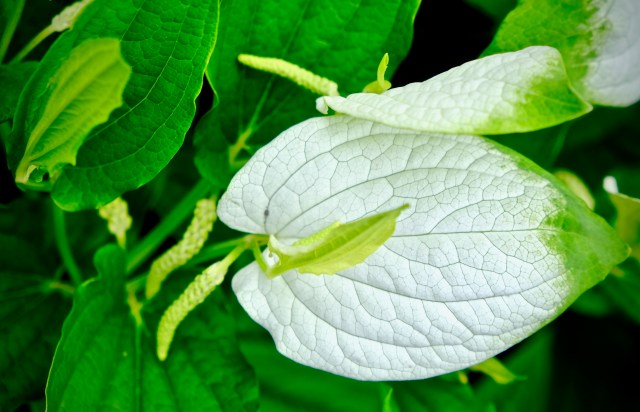A few years ago during the beginning of July, I first came across a unique water loving plant with fascinating nomenclature in both English and Japanese. In English known as Chinese Lizard Tail Plant (Saururus chinensis), it has many tiny, fragrant white flowers on a tapering, stalked spike with a drooping tip, hence the name. Equally, if not more interesting, this plant is called “hangesho” in Japanese. Some people say that the name refers to the phenomenon of the heart shaped leaf’s color changing from green to white as if the leaves were wearing half make up/face paint. This moniker seems particularly relevant to the pond that is famous for its hangesho flowers at Ryosoku-in temple, coincidentally located in the famous Gion entertainment district of Kyoto, where Geisha artists have been painting their faces with white make up for centuries. To reinforce the poetic allusions to “make up” (designed to attract clients), I was fascinated to understand the scientific parallel that the Chinese Lizard Tail Plant’s leaves only turn and remain white, for the short period when the plant is trying to attract various “pollinators” for the subtle and delicate white flowers that are blooming at this time. After pollination has been achieved, the leaves return to their all green color.

The other theory for the Japanese naming of “hangesho” has a distinctly seasonal reference, because the name of the 30th micro-season alludes to the 11th day after the Summer Solstice, which was traditionally when the annual planting of the rice crop would come to an end. This was the time that the medicinal herb Crow-dipper plant or hange sprouted and also the time that the Chinese Lizard Tail plant’s leaves turned color. Thus, “hangesho” marked an important stage in traditional farm work practice. Perhaps not surprisingly, at this time of the year when temperatures were rising amidst heavy rain, it was common to rest and fast for five days. Many people would restrict meat and alcohol intake and therefore recover from the intense planting process. Yet another example of nature providing a punctuation mark that helped regulate the rhythm of daily life. On a side note: in the Kansai region of Western Honshu of which Kyoto is a part, there is a tradition to eat octopus “tako” during this micro-season. Not only is octopus considered to be particularly tender and delicious, “just in season”: shun in this period, this custom also has the added symbolic resonance of imagining newly planted crops sending out deep roots like octopus tentacles.

I also discovered that another wonderful place to see hangesho is at Hogon-in sub-temple, which is part of the Tenryu-ji Zen temple complex in the Arashiyama area of western Kyoto. It was a treat to visit this delightfully lush, green garden this week and in addition to a fine stream that contained many Chinese Lizard Tail plants, the garden also features numerous examples of wonderfully designed bamboo fencing that create a unique rustic and rural ambiance. For me, it was another perfect place to take a rest after the “strains of hard labor” (at the computer) this week.



